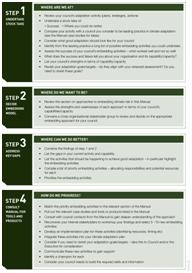Local Resilience to Climate Change

ACELG has released a new resource to assist Australian councils with climate risk assessment and planning activities.
Entitled Climate Adaptation Manual for Local Government: Embedding Resilience to Climate Change, the Manual highlights leading case studies and practical resources from Australian municipalities and overseas, and includes a step-by-step framework for effectively embedding climate risk into council operations.
The resource will be useful for council staff involved in climate risk assessment and planning such as asset managers, strategic planners, and corporate and community services staff.
This ACELG Research Partnership Scheme project was undertaken with local councils from all Australian states: City of Canada Bay (NSW), City of Randwick (NSW), Pittwater Council (NSW), City of Greater Geelong (VIC), City of Port Phillip (VIC), City of Melbourne (VIC), City of Townsville (QLD), City of Onkaparinga (SA), City of Clarence (Tas) and City of Greater Geraldton (WA).
In launching the resource the City of Canada Bay Mayor, Angelo Tsirekas said his council recognised the challenges and impacts of climate change on Australia:
"Our commitment to the environment starts at the top with innovative strategies, developing partnerships and working together with key stakeholders to realise this vision," Mayor Tsirekas said.
"We are proud to have played an important role in developing this manual in collaboration with Australian Centre of Excellence for Local Government and a number of other councils around Australia, and I am confident the manual will become a practical tool for other local governments to make practical and important changes to protect their environments and communities."
ACELG Director, Associate Professor Roberta Ryan welcomed the project:
"This resource addresses a gap about translating existing research about climate change into practical guidance for the benefit of all councils locally.
"A concerted local capacity is vital to respond to and lead communities about adapting to climate change, and I congratulate the partner councils on their involvement in the project- their support has been invaluable."
A workshop hosted by the City of Canada Bay (CCBC) after the launch allowed a number of local government professionals to experiment in applying a number of 'how to' steps from the Manual to their local council circumstances. Staff of CCBC also outlined the approach taken in enabling change and increasing climate resilience in its local government area.
Downloads:
More Information
The development of the Climate Adaption Manual is timely.
Findings from the 2014 Intergovernmental Panel on Climate Change (IPCC) report called Climate Change 2014: Impacts, Adaptation, and Vulnerability suggest efforts by the Australian public sector in building capacity to respond have been strong yet there are differences in methods and a 'weakness' in translating goals into specific policies. The IPCC report also suggests that the absence of a consistent information base and guidelines that 'clarify governing principles and liabilities' is a challenge for some Australian councils (read more).
The ACELG Manual aims to remedy some of these challenges, acknowledging that local circumstances and internal organisational resources will vary greatly in ensuring a council is both adaptable and resilient when it comes to climate change issues.
To effectively use the resource it is recommended that councils follow a four-step review framework to decide where and how to further embed adaptation measures across council operations.
This process would begin by reviewing their initial climate adaptation activities, that is, identifying organisational strengths and weaknesses, together with successes and difficulties encountered in addressing climate risk to date.
|
Four-step process for utilising the ACELG Climate Adaptation Manual to embed climate risk into a council business |
A number of case studies relevant to this this process are provided, such as embedding processes, lessons learnt, and tools. One of many examples covered in the Manual is from the City of Greater Geelong.
"The City of Greater Geelong's Climate Change Adaptation Strategy has provided a clear statement of intent and framework for our organisation to address climate change risks," said City of Greater Geelong Mayor, Darryn Lyons.
"Geelong has identified and will continue to assess exposures to climate change impacts such as an increase in heat waves and many kilometres of coastline that may be impacted by sea level rise.
"Key to the success of the Strategy has been the involvement of all areas of Council from the fellow Councillors Executive Management Team, corporate planning, to managers of our many Council assets and community services."
ACELG and the project partners welcome feedback about this new resource and encourage local governments across the country to consider its use.




